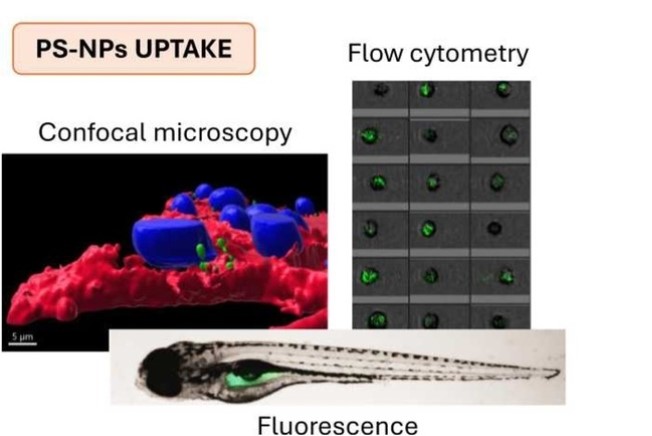New article: "Complex combined effects of polystyrene nanoplastics and phenanthrene in aquatic models"
Research Group: Evolutive Immunology

Abstract:
Nanoplastic (NPs) pollution is an increasing social concern due to their potential to accumulate in aquatic environments and their ability to penetrate organisms. In addition, they can adsorb toxic chemicals from their surroundings and help to transfer them to organisms. This study evaluated the effects of co-exposure of polystyrene (PS)-NPs and phenanthrene (PHE) on toxicity, accumulation, and metabolization in two fish cell lines (zebrafish liver cells and rainbow trout intestinal cells) and in zebrafish. The uptake of PS-NPs was studied by cytometry and confocal microscopy while PHE uptake and metabolization was determined by extraction and detection of the compound and its major metabolites (hydroxy-phenanthrene, OH-PHEs) by gas chromatography coupled to mass spectrometry. Lower uptake of PS-NPs was observed in intestinal cells and zebrafish larvae gut in the presence of PHE, but higher uptakes were observed in zebrafish liver cells. Higher concentrations of PHE and its metabolites were detected in the presence of PS-NPs. Interestingly, zebrafish larvae experienced lower toxicity during co-exposure compared to single exposure. These results indicate that the interaction between PS-NPs and PHE presents a synergistic effect with significant complexity, showing cell-type and tissue dependent ecotoxicological effects and suggesting differential pathways of uptake and distribution of these pollutants.
Article Data:
Paloma De Oro-Carretero, Marlid Garcia-Ordoñez, Nerea Roher, Jon Sanz-Landaluze. Complex combined effects of polystyrene nanoplastics and phenanthrene in aquatic models. Journal of Hazardous Materials, Volume 496, 2025, 139356, ISSN 0304-3894,https://doi.org/10.1016/j.jhazmat.2025.139356.
The UAB, with the Sustainable Development Goals
-
Good health and well-being
